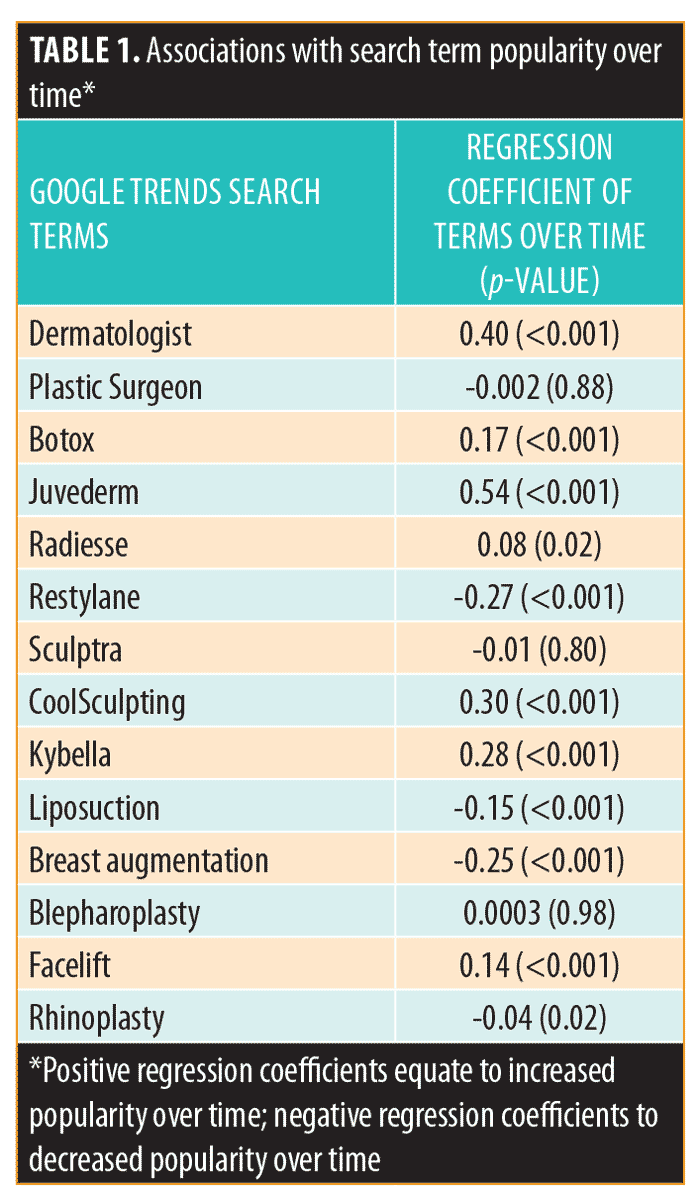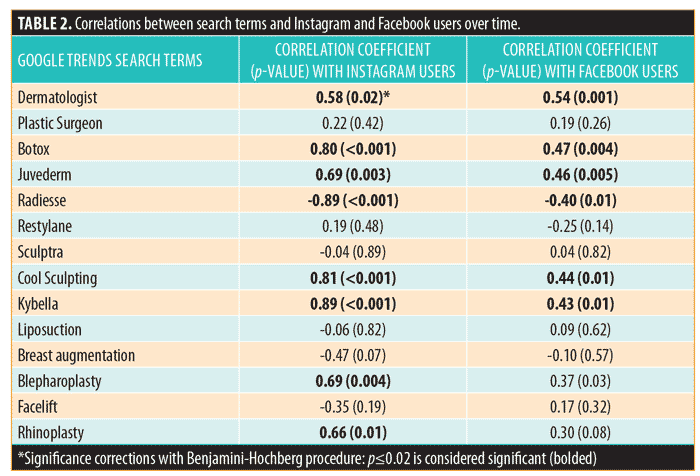J Clin Aesthet Dermatol. 2020;13(1):28–31
 by Zachary H. Hopkins, MD; Christopher Moreno, BS; and Aaron M. Secrest, MD, PhD
by Zachary H. Hopkins, MD; Christopher Moreno, BS; and Aaron M. Secrest, MD, PhD
Dr Hopkins is with the Department of Dermatology at Broward Health in Fort Lauderdale, Florida. Mr. Moreno is with the College of Medicine at Texas A&M University in Temple, Texas. Dr. Secrest is with the Departments of Dermatology and Population Health Sciences at the University of Utah in Salt Lake City, Utah.
FUNDING: No funding was provided for this study.
DISCLOSURES: Dr. Hopkins and Mr. Moreno do not have any conflicts of interest relevant to the content of this article. Dr. Secrest has received research grants from the American Skin Association, National Eczema Association, and National Psoriasis Foundation.
ABSTRACT: Background. Social media is increasingly cited as a contributing factor to the rising public interest in cosmetic procedures. By tracking online search interests, Google Trends (GT) can help quantify these trends.
Objectives. We used GT (trends.google.com) to explore trends in online interest in cosmetic procedures and compare how effects differed by procedure type and their relation to medical specialty.
Methods. Google Trends search term data was collected and compared with annual Instagram and Facebook user counts. Linear regression evaluated search trends over time, and Pearson correlations were used to compare terms. A Benjamini-Hochberg adjustment for multiple comparisons resulted in significance set at p<0.02, except for comparisons between specialties, for which p<0.01 was significant.
Results. The terms dermatologist, Botox, Juvederm, Radiesse, CoolSculpting, Kybella, and facelift are increasing in popularity, whereas the terms Restylane, liposuction, rhinoplasty and breast augmentation are decreasing in popularity (p<0.02). No change was observed for other terms. The terms dermatologist, Botox, Juvederm, Radiesse, CoolSculpting and Kybella were associated with both Instagram and Facebook users, but blepharoplasty and rhinoplasty were only associated with Instagram users (p<0.01). Searches for Juvederm and facelift were only associated with the term dermatologist, and searches for Sculptra, blepharoplasty, and rhinoplasty were only associated with plastic surgeon (p<0.01). For all other search terms, significant correlations were seen with both specialties.
Conclusion. Online interest in noninvasive cosmetic procedures is increasing, potentially driven, in part, by social media. Interest in dermatology is also increasing, creating a need for dermatologists to respond to these shifts in market trends.
KEYWORDS: social media, cosmetic dermatology, cosmetic procedures, public interest, Google Trends
Cosmetic procedures in the United States is increasing.1,2 As physicians trained in providing many of these noninvasive procedures, dermatologists should be aware of trends in public interest regarding these procedures. While the public’s increasing interest is likely multifactorial, social media appears to be a new and impressive driving force.3–8 One study suggested that 95 percent of patients considering a cosmetic procedure had consulted an online source, including social media.6 Studies evaluating the motives of patients for pursuing cosmetic procedures cite experiences with social media as a key factor.3,5 As the reach of social media platforms such as Facebook and Instagram continue to expand, the number of people exposed to information regarding these procedures will continue to increase, affecting both absolute demand and the cosmetic patient demographic mix.4,5,7,9,10
Information available on social media can vary dramatically, from online educational materials and physician-run accounts to patient experiences and advertisements.6,7 In addition, promotions from celebrity accounts can also affect public interest. One article found that online search interest for dermal fillers increased substantially after United States (US) celebrity Kylie Jenner announced she had received Juvederm® lip injections.11
Awareness of trends in public interest can aid physicians in understanding cosmetic market demands and guiding educational efforts. Knowing which products interest patients can guide physician training, product inventory on hand, and educational materials. Since most patients consult online materials regarding cosmetic procedures, one powerful way to track public interest is using Google Trends® (GT), which tracks interest in a topic over time and by location.
The objective of this study was to determine changes in online interest using GT for common invasive and noninvasive cosmetic procedures in the US. We also sought to determine the correlation between these search terms and average number of users over time for Facebook and Instagram. Finally, GT search data for cosmetic procedures was correlated with GT search data for dermatologist or plastic surgeon.
Methods
GT was queried for US searches from January 2004 to December 2017 for the terms dermatologist, plastic surgeon, Botox, Juvederm, Radiesse, Restylane, CoolSculpting, Sculptra, Kybella, facelift, liposuction, rhinoplasty, blepharoplasty, and breast augmentation. We selected the four most popular invasive (breast augmentation, liposuction, rhinoplasty, and blepharoplasty) and the two most popular noninvasive (Botox and dermal fillers) procedures performed in the US, as reported by the American Society of Plastic Surgeons.4 We separated the dermal fillers group into specific brands because brand names are vastly more popular search terms than the general term dermal fillers; we also wished to better understand the popularity of different dermal fillers. The search term microabrasion was not evaluated because it was far less popular than other search terms. Chemical peel and laser hair removal were not evaluated terms as these are commonly performed outside of a physician’s office. We also considered alternate terms, such as generic or colloquial names for procedures (e.g., nose job instead of rhinoplasty); however, surprisingly, medical terms and brand names were more commonly searched.
As a surrogate measure for social media usage, aggregate total annual Facebook and Instagram users were retrieved for all available years: 2008 to 2017 and 2010 to 2017 respectively.12,13
Univariable linear regression was used evaluate trends and popularity in GT search terms over time. A positive correlation (i.e., increasing overall search volume over time) represents an increase in popularity. Aggregate user counts from Facebook/Instagram were compared to search terms over time using Pearson correlation to explore the relationship between search term interest and the growth of social media usage. Additionally, GT search terms for cosmetic procedures were compared to searches for dermatologist and plastic surgeon using Pearson correlation to determine which specialty was more associated with searches for each procedure. Benjamini-Hochberg adjustment with an alpha=0.05 was used for multiple comparisons, and p<0.02 was considered significant. However, for comparisons between specialties (dermatology vs. plastic surgery), p<0.01 was significant. Statistical analysis was performed in STATA v.14.2.
Results
Searches for dermatologist, Botox, Juvederm, Radiesse CoolSculpting, Kybella, and facelift are increasing in popularity over time, whereas searches for Restylane, liposuction, rhinoplasty, and breast augmentation are decreasing in popularity. No significant trend was observed for plastic surgeon, Radiesse, Sculptra, or blepharoplasty (Table 1).

Increasing popularity of the search terms dermatologist, Botox, Juvederm, Radiesse, CoolSculpting and Kybella was associated with numbers of both Instagram and Facebook users (Table 2). The terms blepharoplasty and rhinoplasty were associated with numbers of Instagram users only (r=0.69, p=0.004 and r=0.66, p=0.01, respectively).

Searches for both dermatologist and plastic surgeon were correlated with search terms Botox, Restylane, CoolSculpting, Kybella, liposuction, and breast augmentation (Table 3). Searches using the terms Juvederm and facelift were only associated with the search term dermatologist, while Sculptra, rhinoplasty, and blepharoplasty search terms were only associated with plastic surgeon (p less than or equal to 0.01).

Discussion
Our data demonstrate increasing online public interest in noninvasive cosmetic procedures like Botox, dermal fillers, and body contouring, and decreasing online interest in more invasive procedures like breast augmentation, rhinoplasty, and liposuction, which are similar to that of prior work.14 Given that so many patients consult online sources for information prior to undergoing cosmetic procedures, these data help in understanding market trends and patient demand.6 Overall, these data suggest increasing interest in minimally invasive procedures, potentially owing to media attention, decreased cost, and perceived safety.
Understanding market trends has important implications for physician training and choice of product inventory. One 2013 study suggested that the biggest factors contributing to cosmetic product usage among dermatologists was familiarity with each product and training received in residency on each product.15 This study found that Radiesse® was more popular among physicians than Sculptra.® However, GT data showed that while Radiesse was initially more popular in searches, more recently, Sculptra has become more popular in online searches. These trends in public interest should help guide training on cosmetic products and procedures. Furthermore, since physicians commonly practice independently in different geographic areas from where they train, GT’s local search data can help inform physicians of local product/procedure interest. Physicians can use GT to track cosmetic product interest in their area and tailor their training and inventory to help maximize this interest and provide in-demand products.
Market trends can also improve patient education. For example, we found the search term Juvederm to be the most popular term by a significant margin for dermal filler searches; this indicates the possibility that patients had heard more about Juvederm and were less aware of other fillers for which they might be better candidates. Likewise, as new fillers emerge with certain characteristics, understanding the online popularity may help guide in-office educational materials.
The positive association of many search terms with number of active user accounts on Instagram and Facebook suggests that social media is influencing online interest in these products and procedures, which is supported by multiple survey-based studies.5–8 Social media could not only change public interest levels, but could also change the demographics of patients seeking these procedures. Instagram tends to have younger users who are female, and might drive female patients into cosmetic clinics seeking these procedures at a younger age.16,17 Also, physicians might find that having a social media presence that provides accurate educational information regarding these procedures will increase business for their practices. Additionally, dermatologic and cosmetic academies and societies should also consider using social media platforms (Twitter, Instagram, Facebook, etc.) to provide educational materials and a list of board-certified physicians to patients. For dermatologists, having personal or group-based Instagram, Facebook, Twitter, or other social media accounts provides a platform for educational materials, demonstrations, and discussions of treatment options. Additionally, links to practice websites have become essential in today’s connected age.
Searches related to dermatology are increasing, but not to plastic surgery, which might be due to increased interest in noninvasive cosmetic procedures. As patients become more interested in dermatology, we need to be prepared to meet their increasing online interest with accurate, up-to-date, and ethical educational materials. Patients get much of their healthcare information from online sources , which are of varying quality and accuracy, highlighting the importance of physicians providing high-quality education material online.9,10,18–20 Evidence suggests that websites providing high-quality educational information are powerful influencers on the decisions and perceptions of patients regarding their health. On Facebook, research has shown that educational pages hold the attention of active users most, compared to other types of pages the social media platform offers.21
Limitations. This study has several limitations. GT data are limited to those with access to the internet; however, the patient population seeking these procedures reports high levels of internet usage.6 Currently, GT only has data for Google searches and does not provide any data on searcher demographics. Lastly, associations between searches can depend on many factors, making direct comparison difficult. However, these data do support findings from multiple studies that have shown an association between interest in these procedures and social media usage. Thus, despite these limitations, we believe our data offer valuable insight into market trends regarding cosmetic procedures.
Conclusion
Dermatologists, with their extensive training, are well-positioned to meet the educational and treatment needs of a growing number of people seeking online information on noninvasive cosmetic procedures. Better understanding of market trends through the use of tools such as GT assists dermatologists with meeting the ever-evolving needs of their patients more effectively and efficiently. Additionally, as part of their practice management, dermatologists should consider using social media as a means to provide the public with accurate and ethical information regarding these procedures.
References
- Broer PN, Levine SM, Juran S. Plastic surgery: quo vadis? Current trends and future projections of aesthetic plastic surgical procedures in the United States. Plast Reconstr Surg. 2014;133(3):293e–302e. doi:10.1097/01.prs.0000438053.21634.84
- Ahn CS, Davis SA, Dabade TS, et al. Cosmetic procedures performed in the United States: a 16-year analysis. Dermatol Surg Off Publ Am Soc Dermatol Surg Al. 2013;39(9):1351–1359. doi:10.1111/dsu.12267
- American Academy of Facial Plastic and Reconsgructive Surgery Inc. site. Social media makes lasting impact on industry—becomes cultural force, not fad. January 2018. https://www.aafprs.org/media/stats_polls/m_stats.html. Accessed January 2018.
- American Society of Plastic Surgeons site. New statistics reveal the shape of plastic surgery. 01 Mar 2018. https://www.plasticsurgery.org/news/press-releases/new-statistics-reveal-the-shape-of-plastic-surgery. Accessed 16 Jan 2019.
- Abbas OL, Karadavut U. Analysis of the factors affecting men’s attitudes toward cosmetic surgery: body image, media exposure, social network use, masculine gender role, stress, and religious attitudes. Aesthetic Plast Surg. 2017;41(6):
1454–1462. - Montemurro P, Porcnik A, Hedén P, Otte M. The influence of social media and easily accessible online information on the aesthetic plastic surgery practice: literature review and our own experience. Aesthetic Plast Surg. 2015;39(2):
270–277. - Ross NA, Todd Q, Saedi N. Patient seeking behaviors and online personas: social media’s role in cosmetic dermatology. Dermatol Surg Off Publ Am Soc Dermatol Surg Al. 2015;41(2):269–276.
- Schlichte MJ, Karimkhani C, Jones T, et al. Patient use of social media to evaluate cosmetic treatments and procedures. Dermatol Online J. 2015;21(4).
- Dorfman RG, Vaca EE, Mahmood E, et al. Plastic surgery-related hashtag utilization on Instagram: implications for education and marketing. Aesthet Surg J. 2018;38(3):332–338.
- Park JH, Christman MP, Linos E, Rieder EA. Dermatology on Instagram: an analysis of hashtags. J Drugs Dermatol. 2018;17(4):482–484.
- Ward B, Ward M, Paskhover B. Google Trends as a resource for informing plastic surgery marketing decisions. Aesthetic Plast Surg. 2018;42(2):
598–602. - Number of monthly active Instagram users from January 2013 to September 2017 (in millions). Statista site. https://www.statista.com/statistics/253577/number-of-monthly-active-instagram-users/. Accessed 17 Mar 2018.
- Number of monthly active Facebook users worldwide as of first quarter 2018 (in millions). Statista site. https://www.statista.com/statistics/264810/number-of-monthly-active-facebook-users-worldwide/. Accessed 17 Mar 2018.
- Wilson SC, Daar DA, Sinno S, Levine SM. Public interest in breast augmentation: analysis and implications of Google Trends data. Aesthetic Plast Surg. 2018;42(3):648–655.
- Sandoval LF, Huang KE, Davis SA, et al. Trends in the use of neurotoxins and dermal fillers by US physicians. J Clin Aesthetic Dermatol. 2014;7(9):14–19.
- Cohen C, Alber JM, Bleakley A, et al. Social media for hepatitis B awareness: young adult and community leader perspectives. Health Promot Pract. March 2018:1524839918765438. doi:10.1177/1524839918765438
- Falzone AE, Brindis CD, Chren M-M, et al. Teens, Tweets, and tanning beds: rethinking the use of social media for skin cancer prevention. Am J Prev Med. 2017;53(3S1):S86–S94.
- Buntinx-Krieg T, Caravaglio J, Domozych R, Dellavalle RP. Dermatology on Reddit: elucidating trends in dermatologic communications on the world wide web. Dermatol Online J. 2017;23(7).
- Karimkhani C, Connett J, Boyers L, et al. Dermatology on Instagram. Dermatol Online J. 2014;20(7).
- Zhou J, Bercovitch L. Instagram and the dermatologist: an ethical analysis. J Am Acad Dermatol. 2018;78(6):1226–1228.
- Kim WB, Marinas JEC, Vender RB. Public engagement with dermatology contents on Facebook. J Cutan Med Surg. 2015;19(3):304–308.

